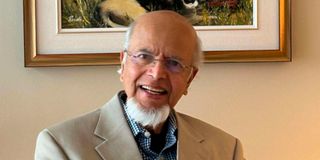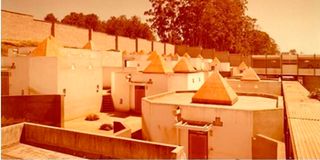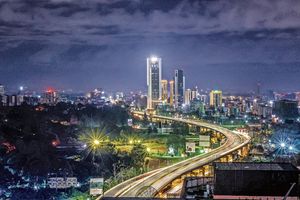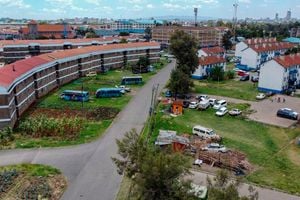
Braz Menezes, a Kenyan-born architect of Goan descent.
American architect Frank Lloyd Wright once said: “The mother art is architecture. Without an architecture of our own, we have no soul of our own civilization.”
Going by that observation, there is one understated man who contributed to creating the soul of Nairobi due to the architectural projects he was involved in as Kenya forged its own identity in the formative years after independence.
That man is Braz Menezes. He was born in Kenya in the late 1930s to Goan immigrants. He is the man who designed, from scratch, the Buru Buru estate, the Kibera New Village (Fort Jesus area), and parts of Loresho North.
He was also the designer of Masai Lodge, the recreational facility in Ongata Rongai bordering the Mbagathi River and the Nairobi National Park. The lodge’s first principal owner was the late politician John Keen.
The uniqueness of the lodge later earned Mr Menezes an invitation to take part in the design of the United Nations Environment Programme (Unep) premises in Gigiri.
Menezes also designed the Kenya Technical Teachers College in Gigiri from scratch and also drew up the structures for the upgrade of the Mathari Mental Hospital.
Equally, Menezes’ architecture firm was the official architectural consultant for petroleum firm Shell for a couple of years.
He was also at some point a lecturer at the University of Nairobi (UoN), the very place he had studied architecture before he travelled to the United Kingdom to study urban housing on a scholarship.
While still studying at UoN, he won a government competition to place decorations in Nairobi to mark Kenya’s Independence Day in 1963.
After years of private practice and as his fame grew locally, Menezes joined forces with Mr David Mutiso, who was at one time the chief architect at the Ministry of Works.
This led to the creation of Mutiso Menezes International, an architecture firm started in 1974 and which is running to date.
The firm is behind structures like SOS children’s villages, the Housing Finance Company of Kenya headquarters, the Sunset Hotel in Kisumu, the Kenya Bureau of Standards offices, the Reinsurance Plaza, the Treasury building, among others.
To keep busy in retirement, Menezes switched to writing. He has documented his experiences in a series of five books he has christened the Matata series.
The books take the form of creative nonfiction, where happenings are relayed in novel format. He is a character in the novels going by the name Lando, an adaptation of his middle name “Orlando”.
The first book in the series was released in 2011 while the fifth came out in December 2023.
The books are: Beyond the Cape: Sin, Saints, Slaves, and Settlers (2011); More Matata: Love after the Mau Mau (2012); Among the Jacaranda: Buds of Matata in Kenya (2018); Soul Searching in the Seychelles (2022); and Tsavo the Money-Eaters: Ghosts of Greed in Kenya (2023).
The launch of the latest book will happen in Nairobi next month.
In a phone interview with Lifestyle, Menezes said he was last in Kenya in 2007, and he remembers it well because of the post-election violence that happened that year.

Braz Menezes, a Kenyan-born architect of Goan descent who is currently based in Canada.
“I won’t be there for the launch (scheduled for April 4) because I have family commitments here, but I will definitely come back on a holiday,” he said.
“David Mutiso wants me to come and retire with him there. It’s not easy when you get old,” he added.
He is one of the persons of foreign descent who stayed put as others migrated in their numbers following the Africanisation policy and radical moves like the expulsion of Indians from Uganda in the 1960s and 1970s.
However, the assassination of Josiah Mwangi Kariuki, which was the third such killing in as many years, made him resolve to move to Canada with his young family.
He remembers asking his wife: “Do you remember the promise I made to you after Mboya’s death…? We will make a decision that’s good for the children. That time has come.”
That is the day he announced to his associate, Mutiso, that he would be moving to Canada “to start life anew” in 18 months’ time.
Menezes remembers going to the Canadian embassy on March 12, 1975 “exactly 10 days after JM was last seen” to submit immigration forms.
He had bought land and built a home in Nairobi’s Lavington area – and even invested in a property in Malindi – but he was not ready to be swayed by those. Today, he lives in Toronto, Canada.
From the latest book in the Matata series – which is a fusion of his private life and his engagements as an architect – we bring you excerpts that reveal the backstory of some Kenyan installations.
When a series of ‘insane suspect’ escapes created a need to redesign Mathari
Menezes’ firm was contacted by the Ministry of Health to be the architectural and planning consultants for the renovation of the Mathari Mental Hospital. The plan was to have a 1,350-bed psychiatric facility.
However, the government wanted a 350-bed maximum security component built first, and there was a reason for this.
He was informed that lawyers had found a loophole at Mathari. It involved them arguing that their clients were insane.
“The judge usually sends an accused criminal to this place first for a pre-trial psychiatric evaluation and before you know it, he’s gone,” Menezes writes, recalling the information he got from a senior architect.
Apparently, he writes, the suspect would walk on an open ground at the facility, breach the barbed wire fence and cross a river to their freedom.
As such, the instructions given to him from the government official was that he was to think of the facility as a prison. As a matter of fact, he was told, the renovation was to be done by the Prisons department but it had no funds for the purpose.
However, when the architect consulted doctors, he was told of the need to have facilities that “contribute to the curative process in their layout, their detailed design, and especially in the design of the therapy rooms”.
He finally came to a consensus on what the design should be, and Menezes notes in the book that the buildings were “more appropriate to Kenya’s specific conditions, especially respecting the cultural background of the patients and with emphasis on keeping operating costs affordable”.
When John Keen asked Menezes to design Masai Lodge
He revisits the day he first met John Keen, then a powerful and well-connected politician, and an associate. They then asked him if he wished to be the architect for a hotel project they were mooting.
“I replied with very obvious enthusiasm that I will be delighted to be their architect,” he writes.
The design he eventually chose, he writes, is “praised especially for the way the structures work themselves into the terrain and blend into the environment”.
“There are no directional signs. The visitor is guided by her or his instinct,” he adds.
When Menezes was featured in the Nation on November 21, 1972, the splendour of the Masai Lodge was the main topic as the facility was set to open the following month.
“We wanted, particularly at Masai Lodge, to get away from this business of lodges looking ‘primitive’ and attempting to give the impression that this is indigenous local architecture, when in fact there is no reason to pretend otherwise. The ‘primitive’ look means that invariably the scale is wrong and the whole thing ends up looking sophisticated and expensive,” he told the late Barbara Kimenye, a Nation reporter then.
How government’s indifference to Nubians affected Kibera house project
His book revisits the plight that faced the Nubians who live in Kenya. They had moved to the country due to the colonial government gathering individuals from its colonies to form the King’s East African Rifles.
“After each of the major world conflicts, WWI and WWII, rather than pay the cost to repatriate the Nubians back to the Sudan, the colonial administration offered them permanent settlement in Kibera and provided an allowance to those that needed it to bring their families to Kenya,” writes Menezes.
However, after independence, government officials were uneasy about accepting Nubians.
At one point, as he was designing the village that would provide better houses for the Nubians, a government official was blunt on his position: “We Kenyans do not want to make Kibera a permanent home for the Nubians.”
While designing the houses, Menezes had to take such issues into consideration, and he says he finally created a design that allows subletting.
In 2017, the Nubian community inched closer to recognition when Kenya’s fourth president, Uhuru Kenyatta, issued title deeds to a 288-acre piece of land.
However, a follow-up by Nation in 2023 showed that the citizenship problem was still unsolved and that members of the community still struggle to get registration documents.
Besides, the same property had been earmarked for the Kenya Kwanza’s affordable housing programme.
How Buru Buru was born
Before the Nairobi estate came to be known as Buru Buru, it was named the Nairobi Eastern Extension Area. It was initially conceptualised to be a home for lower middle-income earners.
One of the instructions to Menezes, whose firm had beaten others to get the rights to carry out the project, was to build 1,000 units for the first phase at the lowest cost.
He describes Buru Buru as “a blank canvas” given to them that they had to fill. Working with other partners in the project funded by the Commonwealth Development Corporation (CDC) among other bodies, they filled the canvas as required.
“The large land area had not hitherto been encroached by squatters, as it [was] marshy land, desolate of vegetation, and covered with black clay (black cotton soil) for part of the site,” Menezes writes.
Because the book also exposes the vested interests by government officials in various aspects of the economy, Menezes discloses that he was once threatened with deportation because he had rejected a delivery of about 25 lorries of stones, which were apparently sent there by a politician who wanted to dig into the budget.

Braz Menezes designed some of Nairobi's iconic buildings and residences including Buruburu and Kibera New Village.
The stones were meant to provide the base for the central spine road at the Buru Buru township. He did not know it yet, but this would attract the wrath of Paul Ngei, then the Housing minister, who at one point made an impromptu visit at the Buru Buru construction site.
Shortly after Mr Ngei’s visit, Menezes was summoned by Geoffrey Kariithi, then the Permanent Secretary in the Office of the President and the Head of the Civil Service.
This was the minister who was supposed to deport him, though it was clear whether the threat could be actualised because Menezes was Kenyan.
After explaining the stones story to Mr Kariithi, the government official commended him for doing “a good job” and assured him that no deportation would happen.
He also relays a warning Mr Kariithi gave: “Do not talk or mention this meeting or what we discussed to anyone…ever.”
Menezes stopped Unep from importing prefabricated concrete slabs for construction
The United Nations Environment Programme (Unep) was establishing itself in Nairobi. Its days of operating in Nairobi without paying rent were coming to an end and they quickly needed to erect structures.
There was a plan to fly in pre-cast concrete blocks from Geneva, Switzerland, to Nairobi to help build structures in Gigiri that would be used for about five years as the main building construction went on.
Menezes was called to have a technical review of that plan and he flatly rejected the plan to import prefab items.
“There were more appropriate solutions and options, given the availability of local materials and a more appropriate technology, an abundance of skilled labour and relative unemployment, the potential to create more local jobs, and so forth. I emphasised that if they went ahead with the HQ’s ideas, they would risk public embarrassment,” writes Menezes.
The Unep officials saw the problem with the plan and abandoned it pronto.
When money for a motel was ‘eaten’
His book title, The Money Eaters, was inspired by the famous 1907 novel by John Patterson, The Man Eaters of Tsavo. The tile came jumping to Menezes after an encounter involving a motel in Tsavo that he designed.
The first payments were made but nothing came afterwards, even as contractors worked on the site to bring the ideas to life.
As Menezes would later learn, the shadowy people behind the motel, which was to be named the Man Eaters Motel, received payments from their banks in the form of loans but did not pay the contractors.

A view of Mathari Mental Hospital as conceptualised by Braz Menezes.
It also emerged that a minister in the government was one of the ghost directors. Contractors who had pumped in their own money in the hope of getting reimbursed suffered massive losses as the project died premature.
He has an apt description of what was left: “The skeleton of the Man Eaters Motel join[ed] the other skeletons of Tsavo.”
His opinion is that the people behind the project were the “money-eaters” of Tsavo.
At the end of his ‘Money Eaters’ book, one cannot help but feel outraged at the shameless way in which officials in the post-colonial government enriched themselves while creating a mass of impoverished citizens at the bottom of the pyramid.









